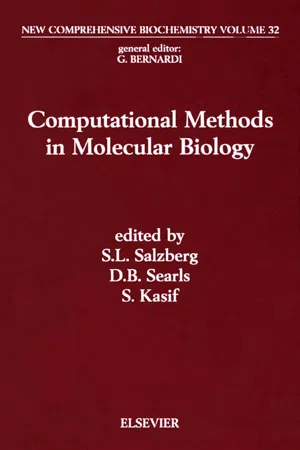
- 368 pages
- English
- ePUB (mobile friendly)
- Available on iOS & Android
Computational Methods in Molecular Biology
About This Book
Computational biology is a rapidly expanding field, and the number and variety of computational methods used for DNA and protein sequence analysis is growing every day. These algorithms are extremely valuable to biotechnology companies and to researchers and teachers in universities.
This book explains the latest computer technology for analyzing DNA, RNA, and protein sequences. Clear and easy to follow, designed specifically for the non-computer scientist, it will help biologists make better choices on which algorithm to use. New techniques and demonstrations are elucidated, as are state-of-the-art problems, and more advanced material on the latest algorithms.
The primary audience for this volume are molecular biologists working either in biotechnology companies or academic research environments, individual researchers and the institutions they work for, and students. Any biologist who relies on computers should want this book.
A secondary audience will be computer scientists developing techniques with applications in biology.
An excellent reference for leading techniques, it will also help introduce computer scientists to the biology problems. This is an outstanding work which will be ideal for the increasing number of scientists moving into computational biology.
Frequently asked questions
Information
Table of contents
- Cover image
- Title page
- Table of Contents
- New Comprehensive Biochemistry
- Copyright page
- Dedication
- Preface
- List of contributors*
- Other volumes in the series
- Chapter 1: Grand challenges in computational biology
- Chapter 2: A tutorial introduction to computation for biologists
- Chapter 3: An introduction to biological sequence analysis
- Chapter 4: An introduction to hidden Markov models for biological sequences
- Chapter 5: Case-based reasoning driven gene annotation
- Chapter 6: Classification-based molecular sequence analysis
- Chapter 7: Computational gene prediction using neural networks and similarity search
- Chapter 8: Modeling dependencies in pre-mRNA splicing signals
- Chapter 9: Evolutionary approaches to computational biology
- Chapter 10: Decision trees and Markov chains for gene finding
- Chapter 11: Statistical analysis of protein structures
- Chapter 12: Analysis and algorithms for protein sequence–structure alignment
- Chapter 13: THREADER: protein sequence threading by double dynamic programming
- Chapter 14: From computer vision to protein structure and association
- Chapter 15: Modeling biological data and structure with probabilistic networks1
- Appendix A: Software and databases for computational biology on the Internet
- Appendix B: Suggestions for further reading in computational biology
- Subject Index